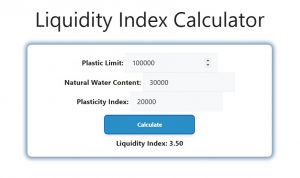About Liquidity Index Calculator (Formula)
The Liquidity Index Calculator is a crucial financial tool used to evaluate a company’s liquidity position. It provides insights into how well a company can meet its short-term obligations with its available liquid assets. A higher liquidity index indicates better financial health, making it an essential metric for investors, creditors, and financial analysts. This calculator helps businesses understand their liquidity status, enabling them to make informed decisions about cash flow management, investments, and financial planning.
Formula
To calculate the liquidity index (LI), use the following formula:
LI = (PL – NWC) / PI
where:
- LI = Liquidity Index
- PL = Current Liquid Assets
- NWC = Net Working Capital
- PI = Planned Investments
How to Use
- Determine Current Liquid Assets (PL): Gather data on all current liquid assets, which may include cash, cash equivalents, and receivables.
- Calculate Net Working Capital (NWC): Determine the difference between current assets and current liabilities.
- Identify Planned Investments (PI): List the planned or expected investments that may impact liquidity.
- Input Values: Substitute the values into the formula.
- Calculate: Perform the calculation to find the liquidity index.
Example
Suppose you have the following data:
- Current Liquid Assets (PL) = $100,000
- Net Working Capital (NWC) = $30,000
- Planned Investments (PI) = $20,000
Using the formula:
LI = (PL – NWC) / PI
LI = (100,000 – 30,000) / 20,000
LI = 70,000 / 20,000
LI = 3.5
In this example, the liquidity index is 3.5, indicating a strong liquidity position.

FAQs
- What is the Liquidity Index?
The Liquidity Index measures a company’s ability to cover its short-term obligations with its liquid assets. - Why is the Liquidity Index important?
It helps assess financial health and liquidity, which is crucial for making informed business decisions. - How can I improve my Liquidity Index?
Increase liquid assets, reduce current liabilities, or plan investments carefully to enhance liquidity. - What constitutes liquid assets?
Liquid assets include cash, bank deposits, stocks, bonds, and receivables that can be quickly converted to cash. - How often should I calculate my Liquidity Index?
It’s advisable to calculate it regularly, especially when assessing cash flow or planning investments. - What is a good Liquidity Index value?
A liquidity index greater than 1 typically indicates a good liquidity position. - Can the Liquidity Index be negative?
Yes, a negative liquidity index indicates that current liabilities exceed available liquid assets, signaling potential financial distress. - How does the Liquidity Index affect creditors?
Creditors often use it to assess a company’s ability to repay short-term debts before extending credit. - Is the Liquidity Index the same as the current ratio?
No, the liquidity index is a more specific measure that considers planned investments, while the current ratio compares current assets to current liabilities. - What impact do planned investments have on the Liquidity Index?
Planned investments can lower the liquidity index if they are substantial, reflecting less available liquidity for immediate obligations. - How do seasonal fluctuations affect the Liquidity Index?
Seasonal businesses may experience fluctuating liquidity indexes due to changes in cash flow and working capital needs. - Can a high Liquidity Index be misleading?
Yes, an excessively high index may indicate that funds are tied up in liquid assets rather than being used for growth opportunities. - Should I rely solely on the Liquidity Index for financial decisions?
No, it should be considered alongside other financial metrics for a comprehensive view of financial health. - What other ratios are important for assessing liquidity?
Other key ratios include the current ratio and quick ratio. - How does the liquidity position affect stock prices?
A strong liquidity position can boost investor confidence, potentially leading to higher stock prices. - What is the difference between liquid assets and working capital?
Liquid assets are specific assets easily converted to cash, while working capital is the difference between current assets and current liabilities. - How do market conditions impact the Liquidity Index?
During economic downturns, liquid assets may decline in value, affecting the liquidity index negatively. - Is the Liquidity Index used in personal finance?
While primarily a business metric, it can be adapted for personal finance to assess cash flow management. - Can the Liquidity Index help in budgeting?
Yes, understanding liquidity helps with effective cash flow management and budgeting strategies. - Where can I learn more about financial ratios?
Consider online courses, financial textbooks, or consulting with a financial advisor for in-depth learning.
Conclusion
The Liquidity Index Calculator is an essential tool for assessing a company’s liquidity and financial health. By accurately measuring the liquidity index, businesses can make informed decisions regarding cash flow management, investments, and financial planning. Understanding this key financial metric allows stakeholders to maintain a healthy liquidity position, fostering growth and stability in an ever-changing market environment.
